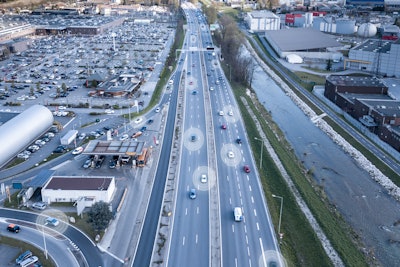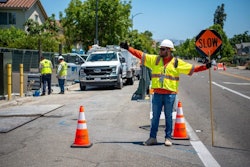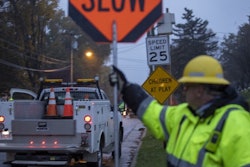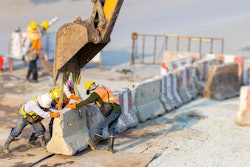
According to the Center for Disease Control, there are more than 750 deaths a year resulting from work zone crashes. These crashes involve both the traveling public and construction workers. Fathers, mothers, siblings, friends.
Making the tragedy worse is the fact that many of these crashes are avoidable. Speed and distraction are the main causes of work zone crashes and many companies are seeking ways to help asset managers better understand their work zones with data.
At the heart of this research is connected vehicle data (CVD) and companies like Wejo who are helping project owners leverage the power of connected vehicle data to better prepare construction work zones and help ensure optimal safety.
"There can be up to 1,000 sensors on a newer vehicle that can give you different insights," Stephanie Ayres, SVP of Enterprise & Channel Partnerships at Wejo. "Insight you can gain can be anything from traffic trends to help understand congestion, all the way through to windshield wiper speed. This can offer insight into how localized weather can effect driving behavior and traffic build-up."
In an effort to both improve safety and future-proof their infrastructure investments, the Indiana DOT (INDOT) partnered with Purdue University and the team at Wejo to advance their understanding of how connected vehicle data could make their roadways safer.
Future-Proofing Road Assets
One of the goals of the team at INDOT is incorporating 21st century technology into their long term road plans. By using CVD like the data Wejo provides, INDOT is able to better manage their road assets.
On the simplest level, INDOT is using the data Wejo provides to stay updated on the condition of their roads.
"Let's say for instance, that there is a pothole, and we have motorists that are swerving around these potholes, you have to think to yourself, you know, that is a safety issue," Pam Fisher, Director of Economic Development for the INDOT says. "If we're able to identify that there is some sort of road condition that is causing motorists to behave in ways other than the ways that we want them to behave, that's something that we need to know now. At the state DOT level, we may not know that for weeks or months until somebody calls or until there's an accident. But with Wejo, here's an example of how we can implement technology to immediately address an issue and again, prevent them from causing accidents"
They also are able to use the data to better plan their road maintenance activities.
"This information allows us to almost inventory our roads and understand what improvements will we be required to make based on this data," Fisher says. "Can we use this data to help us determine what types of improvements we would need to make to prepare for this 21st century technology such as platooning, and connected and autonomous vehicles? Great."
INDOT uses the data to find road assets that are in need of repair and that may have inconsistent road markings.
"If this is all information that can be provided back to us, that's information we can use to enhance future improvements on our roadways," Fisher says.
Cutting Work Zone Incidents in Half
INDOT wanted to take this use of data one step further and deploy resources to their work zones.
The team partnered with Purdue University and studied the why and how behind the accidents that were occurring near work zones. They analyzed accident reports and used vehicle movement insights to understand when hard braking events were happening. Through data analysis, the team quickly uncovered a strong correlation between accidents and hard braking events.
Once Purdue and Indiana DOT came to understand that hard braking could be used as a surrogate measure of safety near a work zone, it was time to start monitoring where hard braking events were happening. Connected vehicle data (CVD) enabled INDOT to look at hard braking events in near realtime – seeing trends in hours or days, instead of the weeks or months that it used to take to understand traffic patterns using roadside cameras.
"That realtime data is important," Fisher says. "If we have issues with work zone safety, and we have to send crews out to identify that, obviously, we're targeting those resources to go and deal with that issue. But then imagine if we're able to use the technology that Wejo provides to us, where they're giving us realtime, information about the condition of our roads. Through that use of technology it allows us to deploy our workforce in other directions while at the same time having a significant improvement in safety on our roads. This is all because we're dealing with realtime information rather than intel that is possibly several hours old before we actually were able to get boots on the ground."
Wejo’s connected car data is able to show where hard braking events were happening, at which mile marker, at which times of day and proximity to the work zone itself. The team identified that the hard braking events were happening because of the “queue," or the line of vehicles slowed or stopped due to a construction zone. These lines in many cases were backing up far from where the actual work zone and cautionary signage was located, meaning drivers were not expecting a slowdown when they hit the queue.
The team then concluded that hard braking events could potentially be avoided by implementing advanced warning vehicles upstream from the queue. Purdue and Indiana DOT used CVD to triage where the most important locations across the state were for new queue trucks and to determine the proximity to the back of the queue they should be deployed.
"Pre-Wejo technology, we would actually have to wait for there to be an incident before we were able to send a crew out to to investigate because again, you know, we're not going to be aware in realtime about that incident," Fisher says. "Now, we have technology that we're able to understand in realtime, there's something going on that's causing traffic to back up on an interstate. We understand that backup queue crashes increase the likelihood of either an accident or a fatal accident. Now, we can send our crews out immediately and address those issues before we have either an accident or a fatality"
After initial deployment, it was critical for Purdue and Indiana DOT to measure if the mitigation efforts were successful in decreasing hard braking events. Wejo says they analyzed activity in two separate work zones – one with a queue truck positioned using CVD and one without. The number of hard breaking events in the work zone with the queue truck was significantly less than the area without it. Using CVD reduced the number of hard braking events by more than half.
The analysis from Purdue and Indiana DOT suggests that cutting hard braking events in half could reduce crashes by 50 percent, meaning a dramatic decrease in injury and fatalities near work zones.
"This data is just crucial for improving and enhancing safety on our interstates, now and well into the future," Fisher adds.

















